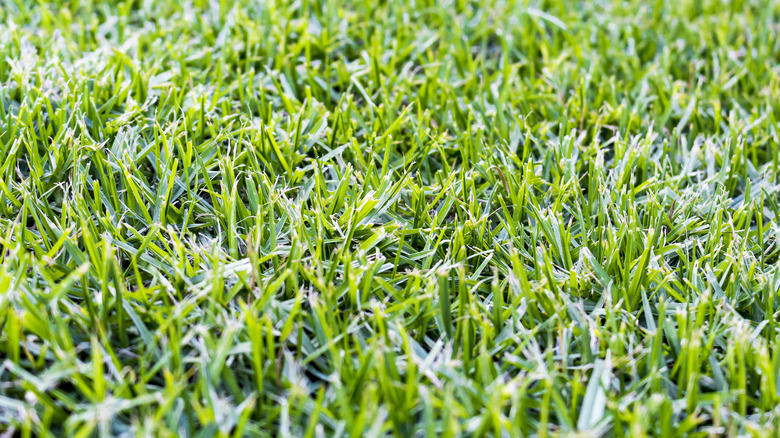This Type Of Grass Is Perfect For Your High Traffic Backyard
There are many things to love about summer, but all those sunny days also mean it's time to break out the yard tools and dust off your lawnmower. According to data published by Today's Homeowner, the average American spends just over 384 hours of their lifetime mowing the lawn — and that doesn't even include other lawncare practices like seeding, watering, fertilizing, and more. It can be discouraging to go through all the work of establishing a healthy, lush lawn, only to have it ripped up and smashed down every time your family or pets step outside. What's the point of having a lawn at all if it can't be used for playtime? If you're looking for a grass lawn that can withstand your busy lifestyle, look no further than kikuyu. Kikuyu grass (Pennisetum clandestinum) is one of the most durable grasses on the planet, able to withstand all sorts of traffic, from footsteps to dogs and even toys and lawn equipment.
Pronounced kuh-KOO-yuh or kuh-KOO-yoo, this hardy grass is one of the best grasses for busy areas that see foot traffic. Here's what you need to know about kikuyu, including its many benefits and some precautions you'll need to take to grow kikuyu turf responsibly.
Kikuyu grass is a resilient choice
Kikuyu grass is native to southern regions of Africa, where it grows in the highlands of Kenya, home of the Kikuyu people. This warm-season grass is surprisingly low maintenance and can survive in loose, slightly acidic soil and hot, dry conditions. While it prefers full sun, this grass can handle a little bit of shade and powers through droughts. In winter, the grass will typically go dormant but will easily come back in spring. Freezing weather is just about the only thing that can knock kikuyu grass down, but even so, the species will bounce back after frosts subside. It's extremely tolerant of foot traffic, recovering from injuries and sprouting new leaves remarkably fast.
Kikuyu grass looks and feels quite similar to St. Augustine grass, with relatively thick grass blades, a somewhat coarse texture, and deep green color. There is more than one kind of kikuyu grass, so weigh your options before taking the plunge. Kenda kikuyu is an excellent choice in terms of durability because each plant has four times as many rhizomes as common kikuyu. Even so, Kenda produces fewer seeds than common kikuyu, making it a more responsible, less invasive choice for close-knit neighborhoods and yards with garden beds.
Caring for your Kikuyu grass
Kikuyu grass is fairly easy to start, as you can sow your kikuyu grass seeds in early spring through late autumn. Water new kikuyu around three times daily for the first two weeks, then once every seven to 10 days. After it's established, mow your grass frequently and no shorter than 1 to 1.5 inches to avoid scalping. Kikuyu grass will develop thick thatching, which can also contribute to scalping, so dethatch the lawn at least once per year in late spring or early summer. Fertilizer isn't usually necessary for this hardy species, but you can give your kikuyu a boost by applying nitrogen fertilizer as early as February, taking a break during peak summer heat.
While kikuyu grass is an awesome, durable turf option, assessing your environment and growing this species responsibly is important. Kikuyu is non-native to North America, and is even considered a noxious weed in some areas. It's not necessarily a "bad" grass, but it can choke out other grass species. Because it grows aggressively, kikuyu grass can quickly take over your yard or escape its designated lawn area. This ability makes it awesome for filling in patchy lawns but not so awesome for in-ground gardens — or neighbors who prefer you keep your lawn on your side of the fence. If you decide to plant kikuyu grass, use caution around border areas and maintain strict edges around the lawn to keep the invasive plants from spreading in your garden.


